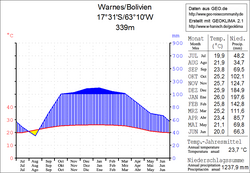Naranjal Don Bosco
| Naranjal Don Bosco | ||
|---|---|---|
| Basic data | ||
| Residents (state) | 689 pop. (2001 census) | |
| height | 313 m | |
| Post Code | 07-0201-0201-0001 | |
| Telephone code | (+591) | |
| Coordinates | 17 ° 24 ′ S , 63 ° 12 ′ W | |
|
|
||
| politics | ||
| Department | Santa Cruz | |
| province | Ignacio Warnes Province | |
| climate | ||
 Climate diagram Warnes |
||
Naranjal Don Bosco was a town in the Santa Cruz Department in the lowlands of the South American Andean state of Bolivia .
Location in the vicinity
Naranjal Don Bosco was the second most populous place in the canton of Azusaqui in the district ( Bolivian : Municipio ) Warnes in the province of Ignacio Warnes in the western part of the Santa Cruz department. The village is located at an altitude of 313 m six kilometers east of the north flowing Río Piraí , thirteen kilometers above the mouth of the Río Guendá . The closest larger towns are Azusaqui , Juan Latino and Las Barreras . Since the 2012 census, Naranjal Don Bosco is no longer listed as an independent town.
geography
Naranjal Don Bosco is located in a tropical, humid climate in front of the eastern edge of the Andes mountain range of the Cordillera Oriental . The region was covered by subtropical rainforest before colonization , but is now mostly cultivated land .
The mean average temperature of the region is just under 24 ° C (see Warnes climate diagram), the monthly values fluctuate between 20 ° C in June / July and 26 ° C from November to February. The annual precipitation is about 1300 mm, the monthly precipitation is productive and lies between 35 mm in August and 200 mm in January.
Transport network
Naranjal Don Bosco is located 43 kilometers north of the capital Santa Cruz and 8 km south of the city of Montero .
Naranjal Don Bosco is located between the cities of Montero and Warnes directly on the 1,657 km long highway Ruta 4 , which crosses the country in a west-east direction, from Tambo Quemado on the Chilean border to Puerto Suárez in the border triangle Brazil- Bolivia- Paraguay . Coming from the west, the road leads via Cochabamba , Villa Tunari and Montero to Warnes, and then on via Santa Cruz and Roboré to Puerto Suárez and across the border to Corumbá, Brazil .
population
The population of the place had increased by almost half between 1992 and 2001:
| year | Residents | source |
|---|---|---|
| 1992 | 478 | census |
| 2001 | 689 | census |
In the region, the Quechua are numerically the most important indigenous people , in the municipality of Warnes 13.5 percent of the inhabitants speak the Quechua language.
Individual evidence
- ^ Instituto Nacional de Estadística Bolivia (INE) 1992
- ^ INE - Instituto Nacional de Estadística Bolivia 2001
- ↑ INE social data Santa Cruz 2001 (PDF; 5.2 MB)
Web links
- Relief map of the Santa Cruz region 1: 250,000 (PDF; 7.88 MB)
- Municipio Warnes - General Maps No. 70201
- Municipio Warnes - detailed map and population data (PDF; 819 kB) ( Spanish )
- Department Santa Cruz - Social data of the municipalities (PDF; 4.99 MB) ( Spanish )
